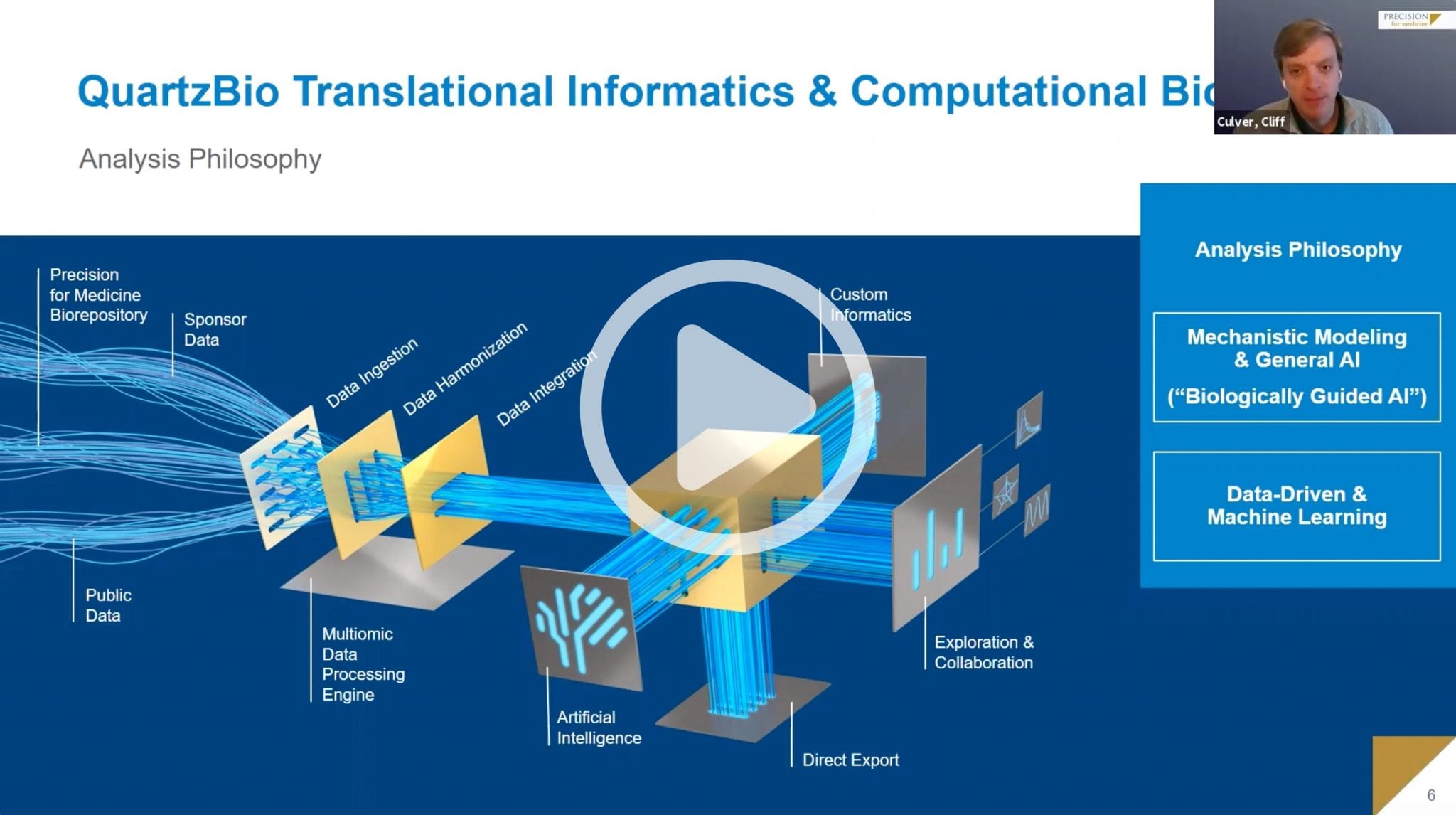Computational Approaches to Enrich, Validate, and Target Biospecimen Analysis, Part 3 – Webinar Summary
PRECISION FOR MEDICINE | WEBINAR SERIES: THE RIGHT BIOSPECIMEN PLAN FOR YOUR RESEARCH PROGRAM

Cliff Culver
Senior Vice President, QuartzBio
Modern therapeutic development focuses on identifying where a drug's mechanism of action (MOA) intersects with a dysregulated biological pathway that causes or exacerbates disease. Applying computational methods to a well-characterized dataset, including those generated from biospecimens, can help accelerate the process of evaluating a compound's MOA in various indications and/or patient populations.
On March 11, 2021, Precision for Medicine hosted Computational Approaches to Enrich, Validate, and Target Biospecimen Analysis, the final segment of a three-part webinar series called The Right Biospecimen Plan for Your Research Program. Precision for Medicine is a global leader in supplying biospecimens, lab services, and CRO services to the life sciences.
Cliff Culver, Senior Vice President, Precision Medicine Group, explored how Precision for Medicine-and the sponsors they work with-leverage computational approaches to drive insight generation and inform critical decisions throughout the research and development (R&D) lifecycle.
Culver highlighted the extraordinary volume of data that is available to sponsors today as new technologies come online and as initiatives to create publicly available datasets mature.

During the course of R&D, translational teams may want to incorporate and analyze myriad unique sources of data, from gene expression and imunosequencing to functional assays and circulating tumor cells. QuartzBio leverages a proprietary platform, including novel biologically-guided Artificial Intelligence that can be used to identify and make connections among diverse biological data to inform disease modeling, pathway selection, and patient stratification (see Figure 1).
Figure 1. Schematic of QuartzBio

Identifying and Prioritizing Rational Target Pathways
Computational approaches can be used to inform critical decisions, whether those decisions relate to focusing data generation strategies or translating data into ongoing clinical planning. A mechanistic approach to computational biology modeling is valuable for identifying and prioritizing target pathways and illuminating biological relationships. The typical workflow for mechanistic modeling (see Figure 2) is to:
- Collect data. These data may include sponsor-generated data, data generated from biobanks, and publicly-available data, such as the Cancer Genome Atlas or the Cancer Cell Line Encyclopedia.
- Map the data to a knowledge base. The QuartzBio platform contains cause and effect relationships that have been curated from prior knowledge. This knowledge base can be interrogated to look for MOAs for a specific drug and then compare those MOAs to disease biology.
- Identify a target pathway. The output from the knowledge base is then used to identify and prioritize rational target pathways.
Figure 2. Workflow for mechanistic modeling

Case Study: Applying Computational Approaches to Mechanisms of COVID-19 Lung Pathogenesis
Culver shared a case study where Precision for Medicine applied a computational approach to determining which non-clinical models best recapitulated human COVID-19 biology. The team at QuartzBio began by identifying and integrating COVID-19-relevant public data sets. Using these data, the team established a disease model and then compared it against existing pre-clinical models. Ultimately, they were able to demonstrate that the A549 cell line model better reflected human COVID-19 biology than alternatives and could be used to screen drugs for mechanistic compatibility.
Creating Translational Data Ecosystems
Increasingly, sponsors are taking proactive measures to link their proprietary data, both clinical and non-clinical, with data available in the public domain, as well as generate custom datasets from biospecimens that contain all the data necessary for their long-term goals. Rather than relying on ad hoc or project-specific data preparation and analyses, they are creating living, dynamic translational data ecosystems. These ecosystems enable sponsors to take full advantage of the breadth and depth of information available to conduct flexible analyses and to surface insights.
Precision for Medicine's mission is to accelerate the pace of innovation and reduce time to market. With the rise of biomarker-informed programs, there has been an explosion of data generation, which has led to an expansion in approaches for driving insights and developing evidence. QuartzBio enables the synthesis, processing, and analysis of diverse data, making it an effective in silico program to complement and de-risk existing in vitro and in vivo efforts.
To learn more, watch the full webinar on demand here.
